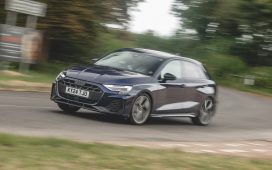A Waymo self-driving car killed a small dog in San Francisco while in “autonomous mode” last month, the latest in a string of incidents that have led city officials to protest a planned expansion of the company’s driverless taxi services.
The 21 May collision occurred just before 11am on Toland Street in San Francisco as the car was in “autonomous mode” with a test driver in the front seat. A Waymo spokesperson said that an initial review showed that the system correctly identified the dog when it ran out from behind a parked car, but “was not able to avoid contact” due to how fast the canine was moving. The company said it was investigating the matter.
“We send our sincere condolences to the dog’s owner,” the Waymo spokesperson said. “The trust and safety of the communities we are in is the most important thing to us and we’re continuing to look into this on our end.”
The car, a Jaguar, sustained minor damage, according to a California DMV report.
The collision comes as Waymo, which is owned by the Google parent company, Alphabet, and its competitor, Cruise, seek to dramatically scale up their robotaxi operations throughout the city. Cruise, operated by General Motors, currently has permission to charge fares for driverless taxi rides between 10pm and 6am in some parts of the city, but its cars must avoid the densest downtown areas. Waymo only has authority to charge fares if a safety driver is present in the car.
The California public utilities commission, which regulates the companies’ robotaxi services, is on the cusp of approving the companies’ requests to operate their self-driving taxis at all hours and throughout the entire city. The commission is set to vote on 29 June on whether to approve draft resolutions that would allow Waymo and Cruise to offer round-the-clock robotaxi service.
But the resolutions have faced fierce opposition from local officials. The San Francisco municipal transportation agency, San Francisco county transportation authority and the mayor’s office of disability authored a letter pushing back on the commission’s plan.
The city has recorded “dozens – perhaps hundreds or thousands – of incidents” in which autonomous vehicles were reported to drive erratically, block traffic and interfere with emergency response operations, officials wrote.
Last year, a viral video showed police stopping one of Cruise’s autonomous vehicles for driving without headlights. When police pulled the car over, the driverless vehicle sped away to the other side of the intersection. In another incident, nearly 20 of Cruise’s self-driving cars blocked traffic for more than two hours, forcing the company’s employees to physically move the cars off the street.
after newsletter promotion
Other incidents include autonomous vehicles trapping other cars at the curb, entering construction zones and crime scenes and failing to follow directions from traffic control officers. San Francisco officials also pointed to a lack of data transparency and adequate reporting and monitoring as reasons for the commission to deny the companies’ requests.
“This approach is backwards and is inconsistent with the commission’s power and duty to protect not only passenger safety but the safety of the general public,” they wrote.








